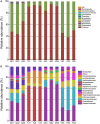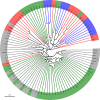Special Features of Bat Microbiota Differ From Those of Terrestrial Mammals
- PMID: 32582057
- PMCID: PMC7284282
- DOI: 10.3389/fmicb.2020.01040
Special Features of Bat Microbiota Differ From Those of Terrestrial Mammals
Abstract
Bats (order Chiroptera) are one of the most diverse and widely distributed group of mammals with a close relationship to humans. Over the past few decades, a number of studies have been performed on bat viruses; in contrast, bacterial pathogens carried by bats were largely neglected. As more bacterial pathogens are being identified from bats, the need to study their natural microbiota is becoming urgent. In the current study, fecal samples of four bat species from different locations of China were analyzed for their microbiota composition. Together with the results of others, we concluded that bat microbiota is most commonly dominated by Firmicutes and Proteobacteria; the strict anaerobic phylum Bacteroidetes, which is dominant in other terrestrial mammals, especially humans and mice, is relatively rare in bats. This phenomenon was interpreted as a result of a highly specified gastrointestinal tract in adaptation to the flying lifestyle of bats. Further comparative study implied that bat microbiota resemble those of the order Carnivora. To discover potential bacterial pathogens, a database was generated containing the 16S rRNA gene sequences of known bacterial pathogens. Potential bacterial pathogens belonging to 12 genera were detected such as Salmonella, Shigella, and Yersinia, among which some have been previously reported in bats. This study demonstrated high resolution and repeatability in detecting organisms of rare existence, and the results could be used as guidance for future bacterial pathogen isolation.
Keywords: aerobic microbes; bacterial pathogen; bat; gut microbiota; sequencing.
Copyright © 2020 Sun, Gao, Ge, Shi and Zhou.
Figures








Similar articles
-
The Threat of Potentially Pathogenic Bacteria in the Feces of Bats.Microbiol Spectr. 2022 Dec 21;10(6):e0180222. doi: 10.1128/spectrum.01802-22. Epub 2022 Oct 26. Microbiol Spectr. 2022. PMID: 36287057 Free PMC article.
-
Fecal Bacteriome and Mycobiome in Bats with Diverse Diets in South China.Curr Microbiol. 2018 Oct;75(10):1352-1361. doi: 10.1007/s00284-018-1530-0. Epub 2018 Jun 19. Curr Microbiol. 2018. PMID: 29922970
-
The fecal bacterial microbiota of bats; Slovenia.PLoS One. 2018 May 23;13(5):e0196728. doi: 10.1371/journal.pone.0196728. eCollection 2018. PLoS One. 2018. PMID: 29791473 Free PMC article.
-
Tools to study pathogen-host interactions in bats.Virus Res. 2018 Mar 15;248:5-12. doi: 10.1016/j.virusres.2018.02.013. Epub 2018 Feb 15. Virus Res. 2018. PMID: 29454637 Free PMC article. Review.
-
Bats and bacterial pathogens: a review.Zoonoses Public Health. 2013 Feb;60(1):93-103. doi: 10.1111/j.1863-2378.2012.01536.x. Epub 2012 Aug 2. Zoonoses Public Health. 2013. PMID: 22862791 Review.
Cited by
-
Microbial community dynamics in blood, faeces and oral secretions of neotropical bats in Casanare, Colombia.Sci Rep. 2024 Oct 28;14(1):25808. doi: 10.1038/s41598-024-77090-6. Sci Rep. 2024. PMID: 39468253 Free PMC article.
-
Bat-associated microbes: Opportunities and perils, an overview.Heliyon. 2023 Nov 18;9(12):e22351. doi: 10.1016/j.heliyon.2023.e22351. eCollection 2023 Dec. Heliyon. 2023. PMID: 38125540 Free PMC article. Review.
-
Characterizing the blood microbiota of omnivorous and frugivorous bats (Chiroptera: Phyllostomidae) in Casanare, eastern Colombia.PeerJ. 2023 Jul 6;11:e15169. doi: 10.7717/peerj.15169. eCollection 2023. PeerJ. 2023. PMID: 37431467 Free PMC article.
-
The fecal microbiota of the mouse-eared bat (Myotis velifer) with new records of microbial taxa for bats.PLoS One. 2024 Dec 5;19(12):e0314847. doi: 10.1371/journal.pone.0314847. eCollection 2024. PLoS One. 2024. PMID: 39637086 Free PMC article.
-
An overview of bats microbiota and its implication in transmissible diseases.Front Microbiol. 2022 Oct 20;13:1012189. doi: 10.3389/fmicb.2022.1012189. eCollection 2022. Front Microbiol. 2022. PMID: 36338090 Free PMC article. Review.
References
-
- Arata A. A., Vaughn J. B., Newell K. W., Barth R. A. J., Gracian M. (1968). Salmonella and Shigella infections in bats in selected areas of Colombia. Am. J. Trop. Med. Hyg. 17 92–95. - PubMed
-
- Canals M., Atala C., Olivares R., Guajardo F., Figueroa D. P., Sabat P., et al. (2005). Functional and structural optimization of the respiratory system of the bat Tadarida brasiliensis (Chiroptera, Molossidae): does airway geometry matter? J. Exp. Biol. 208 3987–3995. 10.1242/jeb.01817 - DOI - PubMed
LinkOut - more resources
Full Text Sources
Research Materials
Miscellaneous

